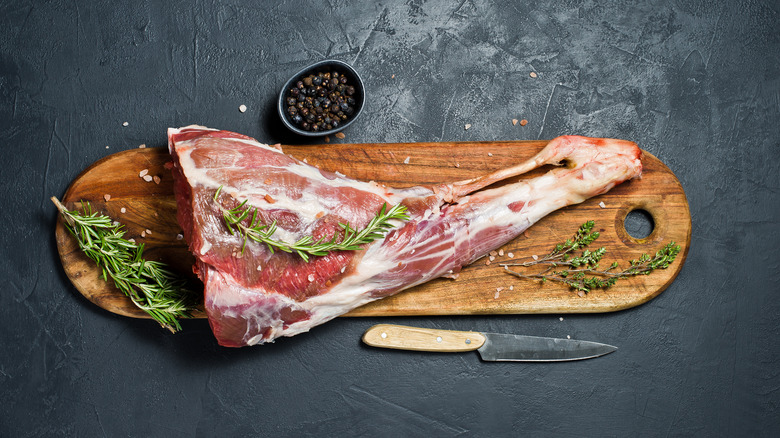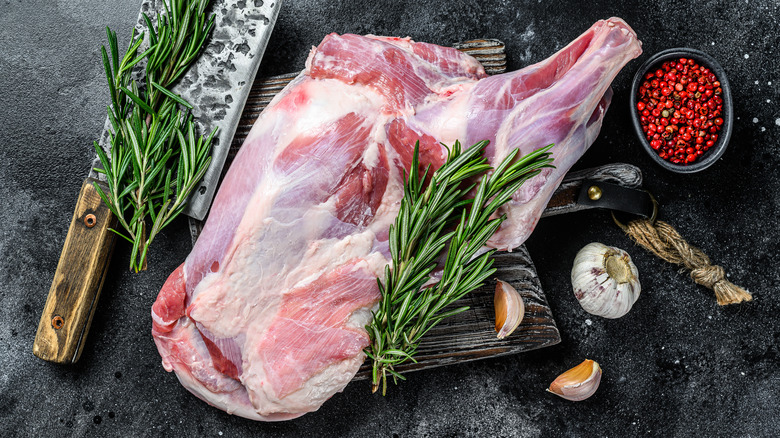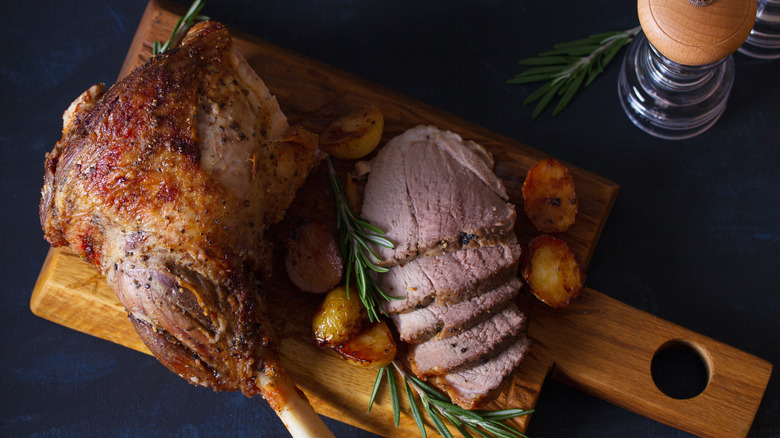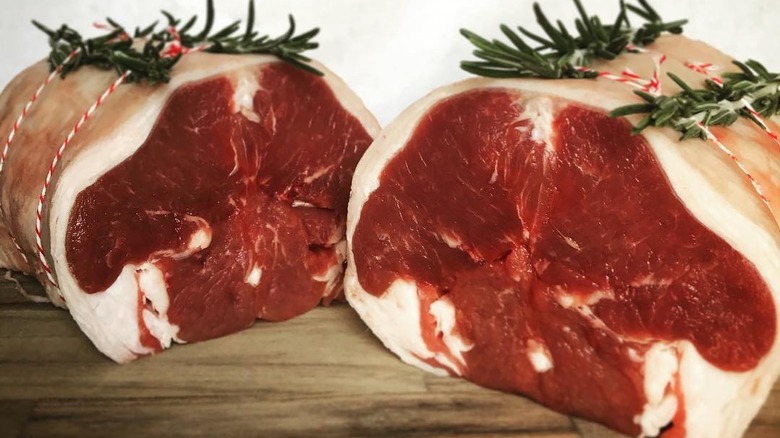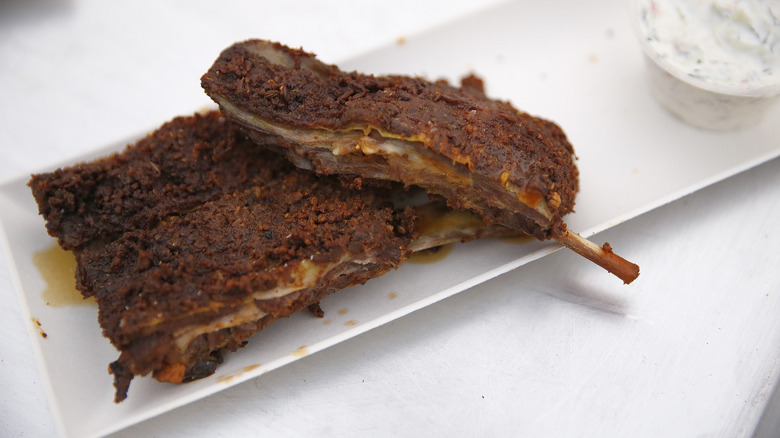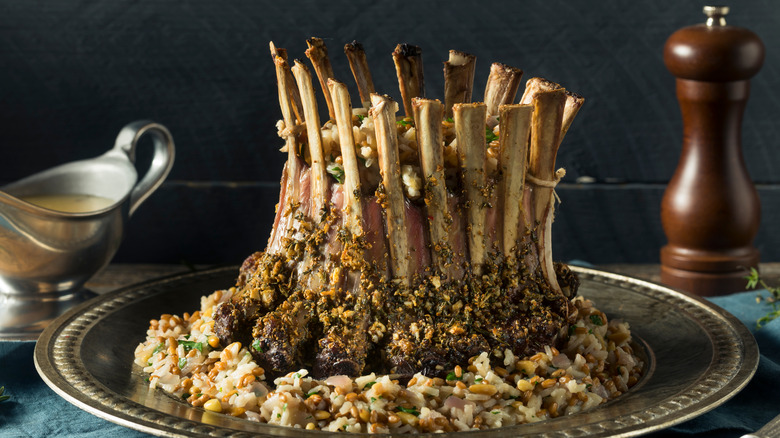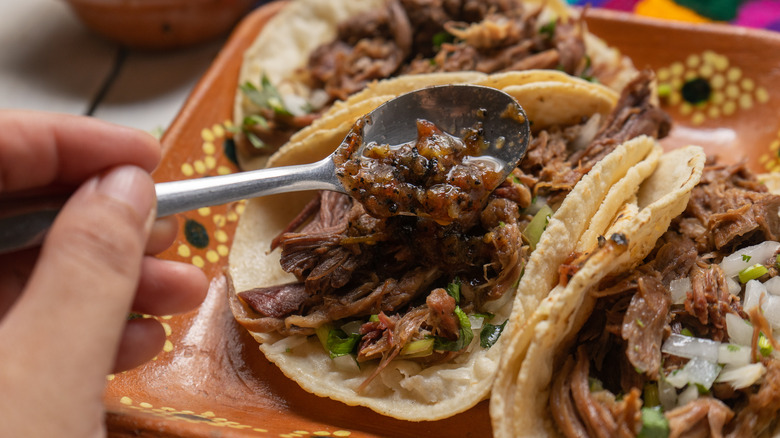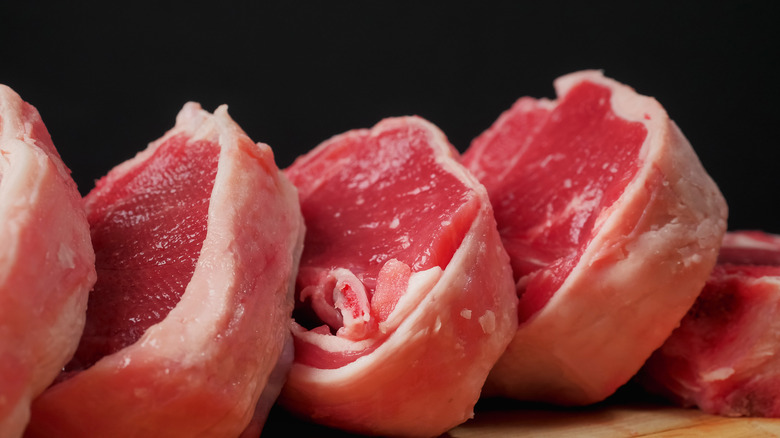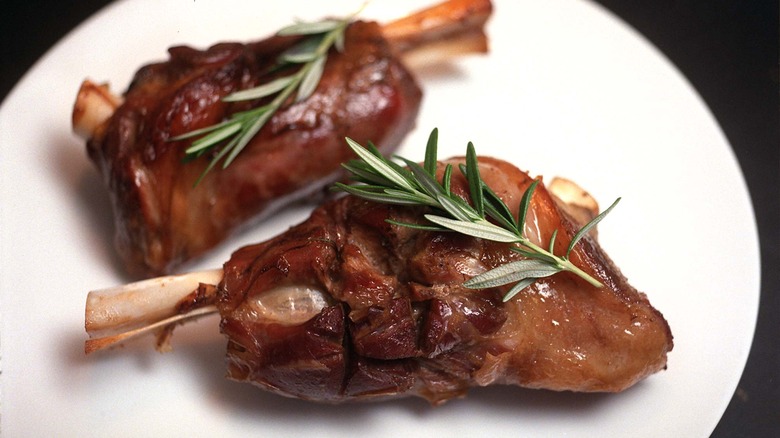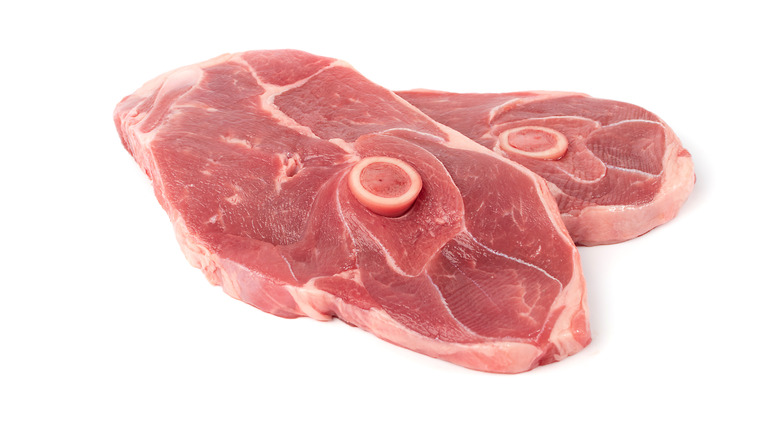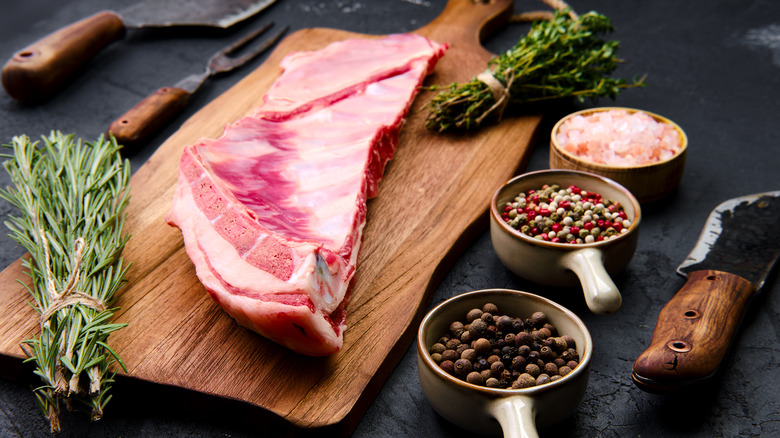The Absolute Best Cuts Of Lamb To Smoke
Lamb tends to be an unsung hero of the meat world. While home cooks may be intimidated by its reputation of being an expensive fine dining staple, there are plenty of diverse and versatile cuts to choose from including affordable options that offer a rich flavor.
Some of the best lamb recipes entail flame-grilling, roasting, or braising the meat. But if you'd like to unlock another level of lamb's flavor profile, put your smoker in the ring. Taking the barbecue approach will yield spectacular results, and will particularly please those who are turned off by lamb's signature gamey attributes which tend to make it a more polarizing protein when compared to milder meats such as chicken or beef. Of course, some people enjoy or ignore that extra funk, but if you dislike it, you can at least add a great smoky flavor to take the spotlight away.
Keep in mind that there are five primal cuts of this animal — shoulder, breast, rib, loin, and leg – each with its own subprimal cuts (via Vincent's Meat Market). They all offer something different, from general pricing to flavors and cooking recommendations. Doing a trial and error cook would certainly be a delicious endeavor ... but also time-exhaustive and pricey. That's why we've broken down the absolute best cuts of lamb to put on the smoker.
Shoulder roast
One of the best lamb cuts to smoke is the impressively-sized shoulder roast, which consists of the muscle at the top of the front legs (via BBQ Champs). This is a leaner cut of meat because of how hard it is worked during the lamb's life. You may be averse to using leaner meats for fear of toughness or dryness, but BBQ Champs explains that lamb shoulder is a great contender for overnight marinating and smoking.
A great thing about the shoulder is that its leanness is equalized by a fair amount of marbling that is still present. The shoulder roast's thick fat cap will also provide some forgiveness, according to Smoked BBQ Source. This is a cut that will certainly benefit from long, low heat to break down collagens for a tender, juicy bite.
Vindulge recommends smoking lamb shoulder at 250 F for 8 to 9 hours, using a fruitwood such as cherry or apple. You can tie up your roast with butcher's twine, if preferred, to create a more uniform cut of meat. Spritz the roast every hour, and once it reaches an internal temperature of 165 F, remove the roast from the smoker, wrap it in aluminum foil, and wait until the final temperature is reached.
Leg of lamb
From the leg primal cut, you get the bone-in leg and boneless leg roast. This is usually split off from the other major cut of the leg (the shank), which is the lower, very lean part. These two cuts are from the upper, fattier part of the leg, but are still leaner than other options due to the muscle structure (via BBQ Champs). According to Craft Beering, the upper part of the lamb is preferred for smoking because of its fattier meat.
Bone-in lamb leg is great when marinated overnight and wrapped before a trip to the smoker. Bone-in vs boneless is a personal preference, but bone-in cuts help with hitting internal temperatures more accurately and reducing the risk of under- or over-cooking, which is important because you don't want to overcook this very lean cut (via Smoked BBQ Source). Some grill experts argue that bone-in meat will always deliver a more intricate flavor profile than boneless meats(via My Chicago Steak), but we will leave that opinion up to you.
Boneless, on the other hand, will smoke quicker if you are pressed for time. Which type of cut you pick may just come down to what is available in your grocery store; because of many home cooks' shyness when it comes to lamb, procuring the leg may require a trip to a specialty butcher. Bone or no bone, leg of lamb will smoke to a deliciously tender finished product.
Loin roast
Taken from the lamb's haunch area (from the last rib to the hip, per Vicent's Meat Market), the loin roast is one of the most tender cuts of lamb. The loin can either be kept intact across the sides (a double loin roast or saddle of lamb) or split into chops, depending on how many people you need to feed (or how hungry you are yourself). This cut is similar to beef tenderloin, according to Pure Bred Lamb, with beautiful marbling and rich flavor.
Because of its unmatched tenderness compared to other lamb cuts, it also carries one of the heftiest price tags, but loin roast is high on our list when it comes to smoking potential. The resulting juicy bite and smoky flavor profile are truly the dynamic duo of barbecue.
That spectacular flavor will level up with an overnight marinade. You could also elevate your smoked lamb loin roast by piercing it with a sharp knife and stuffing the cuts with garlic, rosemary, or other flavors of choice (via Food to Love). Sear your roast before smoking it for an hour and 15 minutes over indirect heat.
Ribs
Lamb ribs are particularly fatty, and with some time in the smoker, the meat will end up buttery-tender and bursting with flavor. Though often hard to find, it's a cut that's worth seeking out, especially if you're a fan of pork spare ribs (via Star Tribune). Sampled when smoked, they will likely turn you into a lamb lover for life. The fat will slowly render and seep into your meat for exquisite results. As a bonus, the technicalities of smoking lamb ribs are quite similar to pork ribs, as Jess Pryles explains, but since they are smaller and thinner, no resting period is necessary, meaning you'll be that much closer to sinking your teeth into a slice of heaven.
Slow smoke a whole rack (around 1-1½ pounds) or multiple racks if you have the room in your smoker and mouths to feed. Simply apply a spice rub and place the rack uncovered in the smoker at 275 F for 3 hours. Just remember to spritz with a water and apple cider vinegar blend every 25 minutes for added moisture and flavor.
Crown rib roast
Follow the lamb map to the upper part of the ribs where you'll encounter the familiar fancy rack of lamb (via BBQ Champs). While you can portion the cut into individual chops, a crown rib roast will bring a sense of regalness to your cookout. Its stunning presentation is the result of tying two trimmed lamb racks together into the shape of the signature royal fashion accessory (via Savor the Best). By smoking this cut of meat, you are combining a prime cut of lamb with covetable layers of flavor — not to mention, it's a gorgeous centerpiece for a dinner spread.
Don't let this cut's stately appearance intimidate you; crown roasts aren't a royal pain to prepare. The hardest part will be assembling your meaty headdress unless you find it pre-assembled from a butcher. Crowns are made by slicing small grooves between each rib, bending each rack into curves, and finally tying them together at the end with butcher's twine (via Over the Fire Cooking). Pro tip: Put together your crown around a circular object, like a peeled onion, for increased stability.
With the hard part out of the way, you can smoke this cut of lamb fully assembled. The resulting meat will be juicy and tender in the medallion, with crispy bark near the bone. Your guests simply grab each rib by the bone (the built-in devouring handle, as we call it) and pull the tender rib off the crown. Bon appétit, your majesty!
Lamb neck
It's no secret that the neck is far from being the golden child of lamb cuts. When cooked improperly, the meat will end up tough and chewy thanks to its dense muscles that saw lots of use in the lamb's life (it's for this reason that the neck can be considered one of the worst cuts of lamb to get overall). But if you know your way around a lamb neck, the underrated and affordable cut can shine thanks in large part to the intramuscular fat that keeps the lamb moist and tender.
According to BBQ Champs, the neck is most often cut into small cubes for kebabs or stews, but a whole neck can be delicious when smoked low and slow. For our braised lamb neck recipe, we recommend bathing the meat in a savory mix of red wine, salt and pepper, garlic, tomato, and a whole garden of aromatics including garlic, celery, onions, and thyme. If you're going the smoker route, this blend could easily be used as an overnight marinade for a whole lamb neck, which your butcher will offer you either bone-in or boneless.
Whether you marinade or simply brine your lamb neck, make sure to season it with cracked pepper and other spices to create a bark. After it's cooked, we recommend shredding the meat as you would for pulled pork and using it for gyros, tacos, or sandwiches.
Loin chops
If you want to prepare mouth-watering lamb loin but in a more manageable portion than a full roast, opt for loin chops. These are simply portioned cuts of lamb loin, butchered from the waist rather than the rib bone. This chop is distinguished by its natural handle that resembles what you would find in a T-bone steak (via Food Network). Loin chops are a tad leaner than rib chops, but the meat is full of flavor as it's a combination of loin and tenderloin.
Loin chops take well to the smoker because they can be done in less than an hour even at low heat. Novice smoke-masters may also find the smaller cut less intimidating, and easier to monitor for doneness. Smoking-Meat.com recommends dry-brining loin chops for two hours, then smoking them with a mix of pecan and applewood at 225 F for 50-60 minutes. Containing around 3 or 4 ounces of meat per chop, these are great for single servings and smaller gatherings, but would also be well-suited as passed appetizers for a large party.
Shank
The shank, which is butchered from the shin (the lower part of a lamb's leg), is a powerhouse of a muscle and an affordable cut of meat. It's leaner than lean, but still undergoes a delectable transformation on the smoker. A slow smoke on low heat is required for this cut to break down the tough muscle fibers and connective tissue (via Smoking-Meat.com).
Shank always comes on the bone and is offered in two subsets of cut: foreshank and hindshank. Foreshank is from the lamb's two front legs, and the hind is from the back. The hind is slightly meatier than the front legs and is ideal if you're looking to serve more than one person, but the flavors in both are not discernibly different.
Because shanks are a tough cut, you'll need moisture on your side to tenderize your meat. In order to maximize the juiciness of your shank, marinate it overnight, keep a pan of water in your smoker, and spritz the meat every hour. Also, be prepared to spend the afternoon smoking your shanks; Mad Backyard suggests this meat will take four to five hours to become fork tender.
Sirloin chop
The sirloin chop is another miniature variety of a large cut: the leg. Like the rib rack or the loin, the leg meat of a lamb can be butchered into smaller pieces, and for the same reasons: smaller portions and different cooking methods.
Sirloin chops are cuts of the leg with a round piece of leg bone in the middle (via BBQ Champs) and are cherished as more affordable options than lamb rib and loin cuts. Also known as lamb steak, it's a quick, easy, and convenient option for smoking. If you're a beginner smoker, it's a great cut to start with and is bound to be less of a challenge than preparing a giant hunk of the leg. According to Healthy Recipes, use a simple seasoning trio of kosher salt, black pepper, and cumin and cook to rare or medium-rare. Don't forget to sear your steak for an irresistible bark.
Lamb breast
Lamb breast may be very fatty, but it can yield excellent results if done correctly on the smoker. This cut of meat (a combination of the belly and brisket) is what remains after the shoulder area is removed (via Texas Monthly). Though it contains quite a bit of gristle and sinew, don't write it off just yet. The thick layer of fat sandwiching the meat forms a confit as it smokes, keeping it juicy even if you happen to overcook it just a bit.
We recommend you trim the flap off the ribs on this cut of meat, but leave the fat intact. You will want it to render and melt over your meat to keep it moist and tender because this area of the lamb can be fickle otherwise.
To nail our smoked lamb breast recipe, cook your bone-in meat at 250 F for 2 hours or until the meat pulls away from the bone and allows a fork to slide in easily. Approach the carving like you would a rib rack and enjoy!
